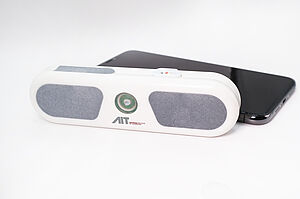The AIT Austrian Institute of Technology is working on the development of a portable blood pressure monitor without a cuff, which is being tested at the University of Applied Sciences Wiener Neustadt (FHWN). This device is designed to record precise vital parameters and facilitate daily blood pressure monitoring.
Although traditional blood pressure measurement with a cuff is well established, it is often impractical and cumbersome in everyday life. People who need to check their blood pressure regularly are faced with the challenge of using bulky devices that are not always easy to handle. Although smartwatches and other wearables already offer functions for measuring vital signs, they often do not fulfil the high medical requirements for accuracy and reliability.
Innovative solution approach through DigiPIT
In the DigiPIT project, funded by the state of Lower Austria, the AIT's Centre for Health and Bioresources is developing a compact blood pressure monitor that does not require a cuff. The device is handy, fits in any pocket and can record precise vital parameters within a few seconds. The data is analysed according to high medical standards via a connection to smartphones or tablets. The prototype is now entering the next test phase in a study at the FHWN.
‘Our aim is to make blood pressure measurement as uncomplicated as possible without sacrificing accuracy,’ says Martin Bachler from the AIT Austrian Institute of Technology. ‘With this innovative technology, we hope to make a contribution to improving prevention and treatment options for high blood pressure.’
Validation studies at the University of Applied Sciences Wiener Neustadt
Wiener Neustadt University of Applied Sciences is supporting the project with extensive validation and applicability studies. State-of-the-art measurement techniques are used at the university's City Campus, which make it possible to precisely measure physiological reactions such as eye movements, skin conductivity and heart rate.
Results of the first studies
Three experimental studies were designed to test the prototype under different conditions:
- Comparison with conventional measurement: In the first study, conducted from September 2022 to January 2023, the trends in the measurement results of the prototype were compared with those of the traditional cuff measurement. The results showed that the cuffless prototype can reliably detect changes in blood pressure and heart rate, even under physical and mental stress.
- Suitability for biofeedback applications: The second study, which ran from September 2023 to August 2024, investigated whether the device can provide precise feedback of blood pressure changes in real time. This is particularly relevant for applications in the field of biofeedback, where patients can learn to influence their own blood pressure through relaxation exercises using immediate feedback. This in turn can be used in the treatment of mild hypertension instead of medication.
- Validation and usability: The third study currently underway is focussing on validating the user-friendliness of the device. This involves analysing how the device can be used in everyday life and how users cope with its operation.
Technical details and measurement methods
The new device uses a combination of a single-channel electrocardiogram (ECG) and a finger photoplethysmogram (PPG) to measure pulse transit time (PTT). This technology makes it possible to indirectly determine blood pressure without the need for a cuff. The measurement of PTT is closely related to the change in blood pressure and the condition of the cardiovascular system. In the new prototype, an additional pressure sensor under the index finger now measures the changing contact pressure. Only by integrating this new sensor is it now possible to measure not only the changes, but also the absolute blood pressure itself.
Prospects and future applications
Now that the third study has been completed, the prototype is almost ready for the market. The device could provide a practical alternative to conventional blood pressure measurement and make daily health monitoring much easier for people with high blood pressure. In addition, the technology opens up new possibilities in telemedicine and in the field of personalised health management.
The collaboration between the AIT and FHWN illustrates how interdisciplinary research projects can develop innovative solutions for current health challenges. The combination of technological expertise and practice-orientated validation can result in a product that both meets medical requirements and is user-friendly.
Link to the FHNW press release: https://presse.fhwn.ac.at/news-blutdruckmessen-to-go-fhwn-und-ait-entwickeln-smarte-messgeraete?id=208282&menueid=11329&l=deutsch
DigiPit project: https://ebooks.iospress.nl/doi/10.3233/SHTI230024
Publication of the results of the first study: https://pubmed.ncbi.nlm.nih.gov/38688296/
Publication on the active principle of the second study: https://journals.lww.com/bpmonitoring/fulltext/2023/02000/Device_guided_slow_breathing_with_direct.8.aspx




